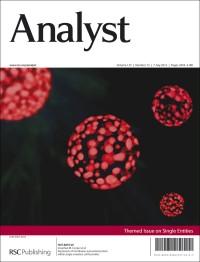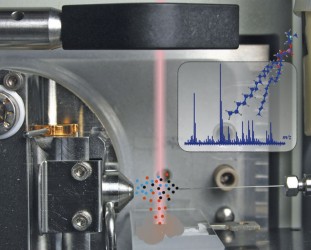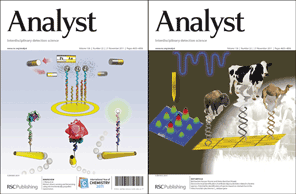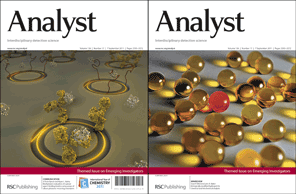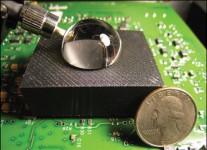 Our web theme on Future Electroanalytical Developments continues to grow, and further papers were featured in the most recent issues of Analyst:
Our web theme on Future Electroanalytical Developments continues to grow, and further papers were featured in the most recent issues of Analyst:
Issue 1
Communication: Alkaline phosphatase enzymatic signal amplification for fast, sensitive impedimetric DNA detection
Miriam Kaatz, Holger Schulze, Ilenia Ciani, Fred Lisdat, Andrew R. Mount and Till T. Bachmann; Analyst, 2012, 137, 59-63
DOI: 10.1039/C1AN15767A
A glucose/oxygen enzymatic fuel cell based on redox polymer and enzyme immobilisation at highly-ordered macroporous gold electrodes
Susan Boland and Dónal Leech; Analyst, 2012, 137, 113-117
DOI: 10.1039/C1AN15537G
Electrocatalytic reaction of hydrogen peroxide and NADH based on poly(neutral red) and FAD hybrid film
Kuo Chiang Lin, Yu Ching Lin and Shen Ming Chen; Analyst, 2012, 137, 186-194
DOI: 10.1039/C1AN15739F
Electrochemical sensor for neurotransmitters at physiological pH using a heterocyclic conducting polymer modified electrode
S. Brillians Revin and S. Abraham John; Analyst, 2012, 137, 209-215
DOI: 10.1039/C1AN15746A
Critical Review: Recent advances in electrochemical sensing for hydrogen peroxide
Wei Chen, Shu Cai, Qiong-Qiong Ren, Wei Wen and Yuan-Di Zhao; Analyst, 2012, 137, 49-58
DOI: 10.1039/C1AN15738H
Issue 2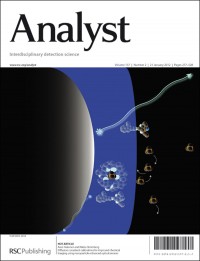
Communication: Sensitive and selective voltammetric measurement of Hg2+ by rational covalent functionalization of graphene oxide with cysteamine
Heng Zhou, Xiang Wang, Ping Yu, Xiaoming Chen and Lanqun Mao; Analyst, 2012, 137, 305-308
DOI: 10.1039/C1AN15793K
Study on electrochemical oxidation behaviors and the diffusion mechanism of hydroquinone at pre-anodized carbon paste electrode by cyclic voltammetry
Linjin Ma, Zhenhui Wang and Quanmin Li; Analyst, 2012, 137, 432-436
DOI: 10.1039/C1AN15865A
Resolution of phenolic antioxidant mixtures employing a voltammetric bio-electronic tongue
Xavier Cetó, Francisco Céspedes, Maria Isabel Pividori, Juan Manuel Gutiérrez and Manel del Valle; Analyst, 2012, 137, 349-356
DOI: 10.1039/C1AN15456G
Electropolymerized network of polyamidoamine dendron-coated gold nanoparticles as novel nanostructured electrode surface for biosensor construction
Reynaldo Villalonga, Paula Díez, Santiago Casado, Marcos Eguílaz, Paloma Yáñez-Sedeño and José M. Pingarrón; Analyst, 2012, 137, 342-348
DOI: 10.1039/C1AN15850C
Redox magnetohydrodynamics enhancement of stripping voltammetry of lead(II), cadmium(II) and zinc(II) ions using 1,4-benzoquinone as an alternative pumping species
Ali A. Ensafi, Z. Nazari and I. Fritsch; Analyst, 2012, 137, 424-431
DOI: 10.1039/C1AN15700K
Graphene electroanalysis: Inhibitory effects in the stripping voltammetry of cadmium with surfactant free graphene
Dale A. C. Brownson, Alexandre C. Lacombe, Dimitrios K. Kampouris and Craig E. Banks; Analyst, 2012, 137, 420-423
DOI: 10.1039/C1AN15967D
Issue 3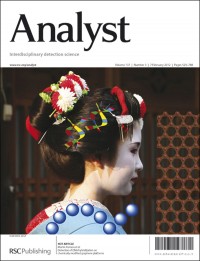
All-solid-state potassium-selective electrode using graphene as the solid contact
Fenghua Li, Junjin Ye, Min Zhou, Shiyu Gan, Qixian Zhang, Dongxue Han and Li Niu; Analyst, 2012, 137, 618-623
DOI: 10.1039/C1AN15705A
A stannum–bismuth composite film electrode for simultaneous determination of zinc(II) and cadmium(II) using differential pulse anodic stripping voltammetry
Nian Bing Li, Wei Wei Zhu, Jun Hua Luo and Hong Qun Luo; Analyst, 2012, 137, 614-617
DOI: 10.1039/C1AN15753A
Transition metal ion-substituted polyoxometalates entrapped in polypyrrole as an electrochemical sensor for hydrogen peroxide
Nargis Anwar, Mikhail Vagin, Fathima Laffir, Gordon Armstrong, Calum Dickinson and Timothy McCormac; Analyst, 2012, 137, 624-630
DOI: 10.1039/C1AN15665A
Towards a detailed in situ characterization of non-stationary electrocatalytic systems
Minghua Huang, John B. Henry, Balázs B. Berkes, Artjom Maljusch, Wolfgang Schuhmann and Alexander S. Bondarenko; Analyst, 2012, 137, 631-640
DOI: 10.1039/C1AN15671C
Non-enzymatic electrochemical detection of glycerol on boron-doped diamond electrode
Aniela Pop, Florica Manea, Ciprian Radovan, Dana Dascalu, Nicolae Vaszilcsin and Joop Schoonman; Analyst, 2012, 137, 641-647
DOI: 10.1039/C2AN15645H



